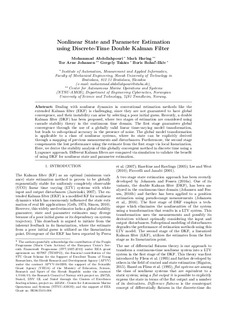| dc.contributor.author | Abdollahpouri, Mohammad | |
| dc.contributor.author | Haring, Mark | |
| dc.contributor.author | Johansen, Tor Arne | |
| dc.contributor.author | takacs, gergely | |
| dc.contributor.author | Rohal-Ilkiv, B | |
| dc.date.accessioned | 2017-12-13T12:13:50Z | |
| dc.date.available | 2017-12-13T12:13:50Z | |
| dc.date.created | 2017-12-09T14:49:17Z | |
| dc.date.issued | 2017 | |
| dc.identifier.issn | 2405-8963 | |
| dc.identifier.uri | http://hdl.handle.net/11250/2471152 | |
| dc.description.abstract | Dealing with nonlinear dynamics in conventional estimation methods like the extended Kalman filter (EKF) is challenging, since they are not guaranteed to have global convergence, and their instability can arise by selecting a poor initial guess. Recently, a double Kalman filter (DKF) has been proposed, where two stages of estimation are considered using cascade stability theory in the continuous time domain. The first stage guarantees global convergence through the use of a globally valid linear time-varying model transformation, but leads to sub-optimal accuracy in the presence of noise. The global model transformation is applicable to a class of nonlinear systems, where its state can be explicitly derived through a mapping of previous measurements and disturbances. Furthermore, the second stage compensates the lost performance using the estimate from the first stage via local linearization. Here, we derive the stability analysis of this globally convergent method in discrete time using a Lyapunov approach. Different Kalman filters are compared via simulation to validate the benefit of using DKF for nonlinear state and parameter estimation. | nb_NO |
| dc.language.iso | eng | nb_NO |
| dc.publisher | Elsevier | nb_NO |
| dc.rights | Attribution-NonCommercial-NoDerivatives 4.0 Internasjonal | * |
| dc.rights.uri | http://creativecommons.org/licenses/by-nc-nd/4.0/deed.no | * |
| dc.title | Nonlinear State and Parameter Estimation using Discrete-Time Double Kalman Filter | nb_NO |
| dc.type | Journal article | nb_NO |
| dc.type | Peer reviewed | nb_NO |
| dc.description.version | acceptedVersion | nb_NO |
| dc.source.journal | IFAC-PapersOnLine | nb_NO |
| dc.identifier.doi | 10.1016/j.ifacol.2017.08.1661 | |
| dc.identifier.cristin | 1525172 | |
| dc.relation.project | Norges forskningsråd: 250725 | nb_NO |
| dc.relation.project | Norges forskningsråd: 223254 | nb_NO |
| dc.relation.project | EC/FP7/607957 | nb_NO |
| dc.description.localcode | © 2017. This is the authors’ accepted and refereed manuscript to the article. This manuscript version is made available under the CC-BY-NC-ND 4.0 license http://creativecommons.org/licenses/by-nc-nd/4.0/ | nb_NO |
| cristin.unitcode | 194,63,25,0 | |
| cristin.unitname | Institutt for teknisk kybernetikk | |
| cristin.ispublished | true | |
| cristin.fulltext | postprint | |
| cristin.qualitycode | 1 | |

